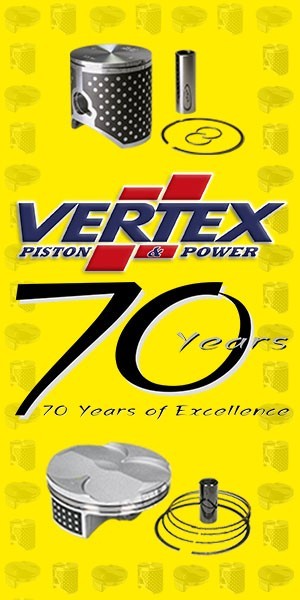Lommel MXdN - 1981
Posted on October 01, 2023
32 years ago, something special happened at the Lommel circuit in Belgium. The history books will tell you, it was the start of something special. The first ever victory at the Motocross des Nations by Team USA. Just like that stunning victory by Germany in 2012 at the Lommel circuit, that has started a European comeback, that 81 des Nations was special for so many reasons. Below is how the event was recalled by the American Motorcycle Museum say it.
The team of Donnie Hansen, Danny LaPorte, Johnny O'Mara and Chuck Sun swept the 250cc Trophee des Nations and the 500cc Motocross des Nations, beginning a 13-year period of domination by the United States of America teams. LaPorte and O’Mara are the first “double inductees” having been inducted on their individual performances in 2000, and now as part of these teams.
In the fall of 1981, an underdog team of four U.S. riders went to Europe and proved once and for all that America had caught on to the sport of motocross. Donnie Hansen, Danny LaPorte, Johnny O'Mara and Chuck Sun swept the Trophee des Nations (250cc) and the Motocross des Nations (500cc) that year, beginning a 13-year period of domination by U.S. teams in the prestigious Olympic-like competition.
The 1981 U.S. team, captained by motocross racing legend Roger DeCoster, pulled off one of the biggest upsets in the history of motocross racing. Hansen, LaPorte, O’Mara and Sun, along with Speedway World Champion Bruce Penhall, were named co-winners of the AMA Pro Athlete of the Year Award in 1981. The four riders who participated in thats year’s des Nations forever etched their names in the lore of motocross.
The United States came late to motocross. On this side of the Atlantic, flat track and road racing were the dominant forms of motorcycling sport for years. After World War II, scrambles racing emerged from the popularity of TT Steeplechase racing. During the 1960s, scrambles became more and more like the European version of closed-course, off-road motorcycle racing called motocross.
In 1967, Edison Dye brought over many of the top European motocross riders to compete in a series of races in America. The European riders dominated their American competitors and inspired a new generation of riders to take up the sport of motocross. Before long, motocross was the fastest growing form of motorcycle racing in the United States as European and Japanese motocross bikes flowed into the country to meet the exploding demand.
By the early 1970s, the AMA had established a motocross championship in the Trans-AMA Series, but the European riders still won most of the races and titles. By late in the decade, the burgeoning popularity of the AMA National Motocross Series lessened the importance of the Trans-AMA Series and head-to-head competition between the top American and European riders was confined to select World Championship Grand Prix rounds and the annual Motocross and Trophee des Nations.
U.S. teams came close to victory a couple of times in the 1970s, finishing runner-up in the Motocross des Nations in 1974 and 1977, and by the 1980s it was thought that the talent in the United States was on par, if not better than, the best in the world. The 1981 team initially chosen to go to the des Nations featured many of the best motocross racers in America, but several of the manufacturers could not justify the expense of sending a team and dropped out at the eleventh hour.
For a while, it looked like the United States would not send a team to the competitions, but a group of industry enthusiasts, spearheaded by Hi-Point’s Larry Maiers and Motocross Action Magazine’s Dick Miller, convinced Honda to enter its American motocross team in the des Nations. Honda, its sponsor Bel-Ray Lubricants, along with funding raised through T-shirt and product sales and donations, raised the money necessary to field a team.
The team’s arrival in Europe was not a warm one. The “no-name” B-team of Honda riders was scoffed at by des Nations officials as being unworthy of participating in the prestigious des Nations competition. Even the riders themselves came only hoping to do well and salvage a bit of respectability for American motocross.
But the four riders truly were a team. They worked together, ate together and planned strategy as a unit. Hansen, LaPorte, Sun and O’Mara were determined to prove they had what took to put a winning effort together.
The warm-up for the U.S. team was the Trophee des Nations, the younger sibling of the more established Motocross des Nations. The Trophee des Nations was held on a sandy circuit in Lommel, Belgium. The host Belgium team was the defending winner and was thought to be nearly unbeatable on the unique Lommel track. The Belgians were exempt from the 20-minute qualifying motos, so when the U.S. team emerged from qualifying in first place, pundits predicted they would crumble in the final, which consisted of 40 minutes plus two laps.
Among the crowd on hand to cheer on their fellow Americans were motocross stars Mike Bell and Marty Tripes, both in Europe to race in a European Supercross event. Before the race, Bell told a reporter that he had a good feeling about the U.S. team’s chances.
“These guys are determined to win,” he said. “In the past, some guys just looked at the des Nations as a way to get a free trip to Europe, but not these riders.”
Belgium’s Andre Vromans won both motos, but it was the Americans who scored the most points and took a surprising victory. O’Mara, LaPorte and Hansen finished second through fourth in the first moto, and in the second LaPorte and O’Mara were second and third. The U.S. team had easily beaten the host Belgians with a score of 20 to 37. The Dutch squad was third.
A week later it was on to the big prize, the Motocross des Nations, held on a hilly circuit in Bielstein, West Germany. The Americans didn’t have the good fortune they had a week earlier and were forced to work hard in both races and make a dramatic come-from-behind run for the victory.
Hansen won in the first qualifying race in spite of the fact that he was a 250 rider and unaccustomed to racing the powerful open-class motocrosser.
“I felt slow,” said Hansen. “But I guess that’s how it’s supposed to feel on these big bikes.”
LaPorte managed a 10th despite crashing and breaking both his front brake and clutch levers. In the second qualifier Sun took a solid second and O’Mara 11th, after not making a hill and having to go back to the bottom and re-ascend.
The starting gate accommodated only 24 of the 32 starters. Each country would have a rider starting from the back row. LaPorte got the call for the U.S. team.
In the first moto, Sun was the leading American rider out of the gate in sixth. Hansen was just inside the top 10. O’Mara was in trouble after being caught up in a first turn pileup.
Troubles for the Americans multiplied, but the riders pressed on. The chain fell off Sun's bike a couple of times. Hansen’s throttle stuck open and he ran off the track, but was able to hold on to second. O’Mara was hit and pushed off the track by a Russian rider and lost three or four positions. And LaPorte was hit in the neck by a big rock and could hardly breath. Still Hansen and LaPorte managed to finish inside the top 10, Hansen second and LaPorte sixth. But Brits filled the top 10 and lead the standings going into the second moto.
The chaos wasn’t confined to the track, either. The squad’s head mechanic, Dave Arnold, had barely enough parts to keep all the bikes running and the mechanics were desperately doing last-minute work on the bikes right up to the start of the race.
Panic struck the U.S. squad when the rear tire on Hansen’s bike went flat just minutes before the start of the second moto. The crew quickly installed a new tube and he was ready to go just in the nick of time. Rain began and the second moto became a mud race.
Finally, things started to go the Americans' way. The British team was having problems, with Graham Noyce’s bike suffering a flat, relegating him to a snail's pace, and his teammate, Geoffrey Mayes, crashed and ran well back in the pack.
Sun crashed and aggravated an ankle injury, forcing him out. That would put even more pressure on the remaining three riders to score well. LaPorte was moving through the field, spurred on by the pit board reading “Need Points!” and “Must Pass!”
“It was hard to tell your position,” LaPorte remembers. “My goggles were so fogged up and it was a mess out there.”
The team was keeping a running tally and when the Americans took the lead two laps from the end, “all hell broke loose,” said American mechanic Bruce Lunnis. At the flag, LaPorte made a heroic charge all the way up to second. O’Mara was eighth and Hansen 13th. Although the numbers looked promising for the U.S., no one was really sure if they’d won. Adding to the drama was the fact that the announcer read out the names of the lower placing teams first. When it was announced “Great Britain, second with 43 points,” the American camp erupted into sheer bedlam. The U.S. had won the Motocross des Nations by a single point, becoming only the sixth country to ever take victory in the Olympics of Motocross.
Bel-Ray’s J.J. Handfield echoed the feelings of the rest of the Americans. “Absolutely the high point of my 12-year association with motorcycling,” he declared.
DeCoster was equally proud of his underdog squad. “It was very exciting,” he said. “I had to convince American Honda that this was worth the cost. Everything went better than we expected. We knew we’d do well, but had no idea that we would do this.”
Honda proudly promoted the des Nations victory in advertisements done up in red, white and blue. The victory launched America into becoming the powerhouse in all of motocross. The U.S. would go on to set an amazing Motocross des Nations record of 13 straight wins and it all started with an upstart team of underdogs in September of 1981.













